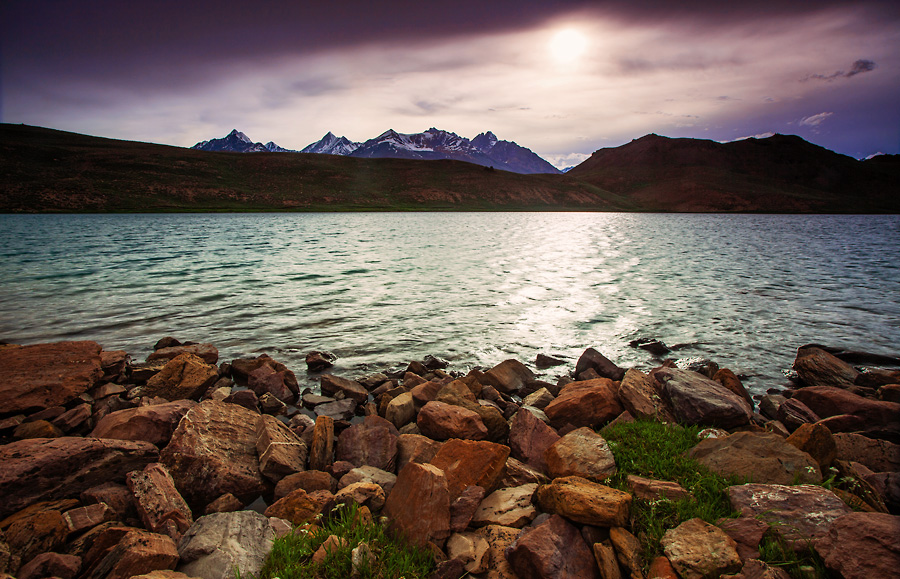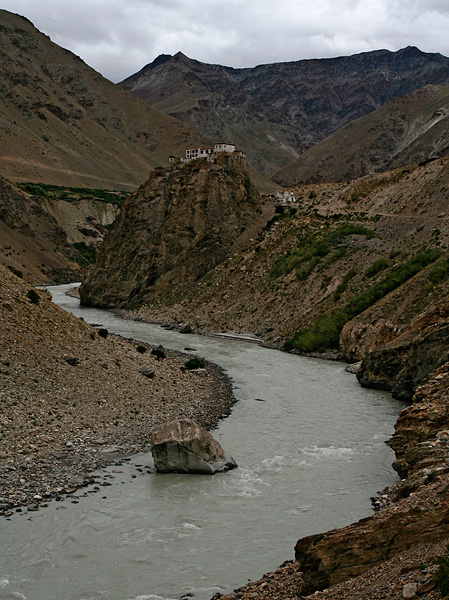Regular readers have seen many images from Chandratal on this blog in the past. Here is another one from a recent trip.

Chandratal Lake is a place I have been going to for a few years now. It’s a beautiful lake located in Lahaul & Spiti Region in the Himalayas. I made my fifth visit a few weeks ago.
The first few images at this place came easy. When the sun is shining and the air is still, the lake reflects everything within the view. It assumes the blue of the sky, and the reflection is so perfect that you can’t see the lake’s waters in a photograph.
Challenges, however, begin when you are done with easy-to-make images. It helps when the weather gods show different moods.
This time when I was there, it was windy and the lake surface was restless. There was a thin layer of cloud through which the sun was barely visible. Here is one of the resulting image.
I was exploring more on the photography opportunities in the area, and it appears that the place holds a promise. Perhaps the next time around, I will look at spending more time at the lake and the places around it.
In the summer of 2008, I travelled extensively in Ladakh spending two memorable months in the mountain country. Then, I had quit my corporate job a few months ago and was enjoying my time seeing the country. I travelled on budget, taking public transport as much as possible and living in home-stays in the villages. At the end of my trip, I exited Ladakh by making a two day bus journey to Padum in Zanskar and then making the nine-day trek through the mountains that led me to Darcha in Himachal Pradesh. The duration of Padum to Darcha trek is reducing every year, with a new motor road in the making I maintained a journal for much part of the journey to Ladakh, including this trek. Here a detailed trek-log, much of it taken as-is from the journal.
Padum to Darcha Trek
The road to Darcha goes along Lungnak River, steadily climbing up until the river’s origin near Shingo-la Pass. We begin from Padum on an unmetalled road, under construction from the venerable Border Roads Organization. Some day, when this road is ready, the entire stretch of our trekking route will be replaced by a highway that will probably be just wide enough for a vehicle to pass. But that’s just how Himalayan Roads are. The trek-route will be defunct then, so there is a sense of urgency in doing it now.
It’s a smooth walk from Padum along the road till we reach Bardan, the next village on the way. There are a few streams breaking the path that disturb the monotony of walking on the road. At Bardan, a monastery dominates the village landscape, standing on a crag at the end of a smooth curve of the river. Beyond the monastery, the mountains plunge into a deep gorge carved by Lungnak River.

Bardan Monastery and Lungnak River
Just before the arriving at monastery, I see a tiny rodent that runs pasts me into its hiding in a wall built from rocks. I wait for it to come out, keeping my camera aimed at its hole. It sure does, carefully checking out for enemies from its safety. I take a few pictures, which later help me identify it as a Himalayan Pika. A few minutes of walking later, I encounter a white rumped swallow-like bird and a red-tailed bird, neither of which I am able to name.
In July this year, I spent a week travelling through the high Himalayan region of Lahaul & Spiti in Himachal Pradesh. This was my fourth visit to the region and I was leading a small group of photography enthusiasts with me. Being a regular visitor to these places, I had had some definite ideas about the subjects that I wanted to shoot, the moods that I wanted to portray and also had a fairly good idea about the time of the day that would help me make those images.
In Dhankar Monastery, seen in the photograph, I was keen to portray the remoteness of the place and the precarious location where the monastery stood. I had also realized that the evening light from behind the monastery would help differentiate the crag on which the buildings were located and the high mountains that dominated the landscape behind it. Here is the image I created that evening. The dust rising from behind helped enhance the drama in the scene.

There is, in fact, much more drama than what is seen in the photograph. At the valley just below the monastery is the confluences of Spiti and Pin Rivers, and the view is fabulous from the place where I was shooting. Yet, I decided to exclude that from the frame, since having too many elements of interest may have driven away attention from the main story and would work counterproductive in this situation.


